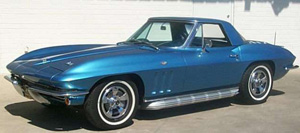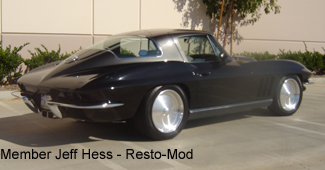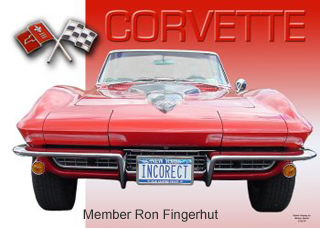
The '66 was the next-to-last version of the first-generation Sting Ray series. Larry Shinoda created the body for the original Sting Ray, a racing car inspired by the sea creature of the same name. GM styling chief William Mitchell loved the design and it was brought into the showroom in 1963. The public embraced it, too, as production climbed from 14,531 in '62 to 21,468 in '63.
The Sting Ray series was the first Corvette line to offer a true coupe. Previously, a detachable hardtop was optionally available for the convertible. The open model continued to be offered in the Sting Ray series and was always more popular than the coupe. In '63, the coupe had a unique split-rear-window design, but this did not continued on later models because the divider between the two windows made rear vision hard.
In '63 and '64 the Sting Ray body had two horizontal windsplits or vents just behind the front wheel housing. In '65 and '66, rear-slanting vertical louvers were used in place of windsplits. Separating the two years were several trim and styling changes. The '66 model used a new cast-metal egg crate grille. It also had a "Corvette" script on the right front edge of a smoother new hood. Other distinctions for '66 included ribbed rocker panel moldings, chrome-plated exhaust bezels, spoke-style wheel covers and the elimination of roof vents on the coupe. Inside, the seats had extra pleats and, below the hood, you could get a new 427-cid big-block V-8.
The base engine was a 327-cid 300-hp V-8 (code L75) with 10.5:1 compression and a single Holley four-barrel carburetor. There were three optional four-barrel V-8s: the 327-cid 350-hp L79 with an 11.0:1 compression ratio, hydraulic lifters and a hi-po cam; the 427-cid 390-hp L30 with 10.25:1 compression ratio, hydraulic lifters and a hi-po cam; and the 427-cid 425-hp L72 with an 11.01 compression ratio, solid lifters and a special performance cam.
Transmission options included a standard three-speed, an automatic, a four-speed and a special high-performance four-speed. A 3.55:1 rear axle ratio was standard, but options included 3.08:1, 3.36:1, 3.55:1, 3.70:1, 4.11:1 and 4.56:1.
With a 98-inch wheelbase, the '66 Vette stretched 175.2 in. end to end. The coupe was just 49.6 in. high. Overall width was 69.9 in. with a 57.6-in. wide front tread and 58.3-in. rear tread. Standard tires were size 7.75 x 15 Red lines and buyers could chose between optional gold sidewall or white sidewall styles.
The coupe, Model 37, carried a base price of $4,295 and accounted for 9,958 assemblies. The convertible cost $4,084 and 17,762 were built. The L79 engine option was $103.35, the L36 was $181.20 and the L72 was $312.85. Other options that collectors look for today include four-speed gearboxes, the N32 teakwood steering wheel, the N03 36-gal. fuel tank designed for competition cars and the N11 off-road exhaust system.
9,958 assemblies. The convertible cost $4,084 and 17,762 were built. The L79 engine option was $103.35, the L36 was $181.20 and the L72 was $312.85. Other options that collectors look for today include four-speed gearboxes, the N32 teakwood steering wheel, the N03 36-gal. fuel tank designed for competition cars and the N11 off-road exhaust system.
’66 VETTE FACTS
|
|
|
VEHICLE IDENTIFICATION NUMBER
|
194376S100001 through 194376S127720 Coupes. 194676S100001 through 194676S127720 Convertibles. The first symbol 1 indicated Chevrolet. The second and third symbol identified the body series 94 = Corvette. The fourth and fifth symbol indicated the body style 67 = convertible; 37 = coupe. The sixth symbol indicates the model year 6=1966. The seventh symbol identifies the assembly plant (S= St. Louis). The last six symbols indicate the sequential production number.
|
|
ENGINE
|
BASE ENGINE
Type: V-8
Bore and stroke: 4.00 x 3.25 in.
Displacement: 327 cid
Brake hp: 300 at 5000 rpm.
Carburetor: Holley 4-bbl
OPTIONAL ENGINES:
327-cid/350-hp w/Holley 4-bbl
427-cid/390-hp w/Holley 4-bbl
427-cid/425-hp w/large Holley 4-bbl
|
|
VITAL STATS
|
Coupe
Original Price: $4,295
Production: 9,958
Wheelbase: 98 in.
Length: 175.3 in.
Tires: 7.75 x 15
Convertible
Original Price: $4,084
Production: 17,762
Wheelbase: 98 in.
Length: 175.2 in.
Tires: 7.75 x 15
|
|
COOL STUFF
|
• Back up lights became standard equipment.
• Holley carburetors were standard with all 1966 engines.
|